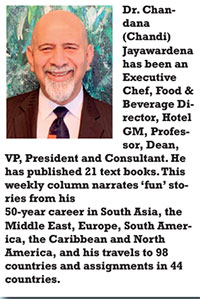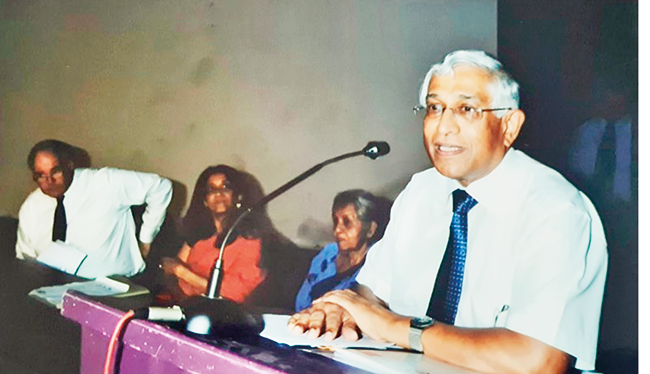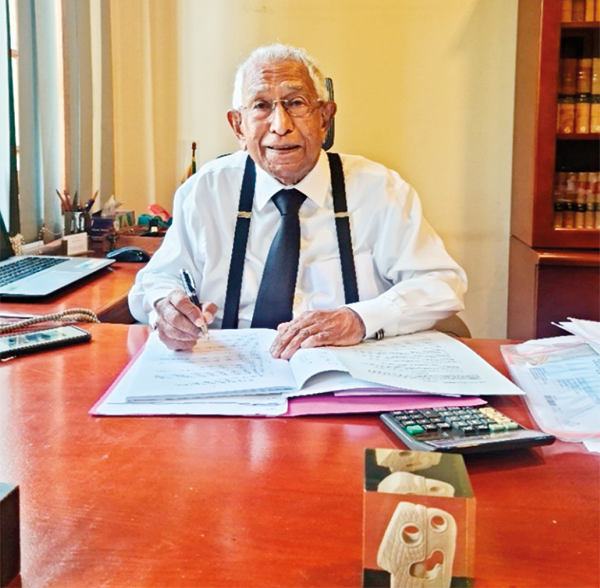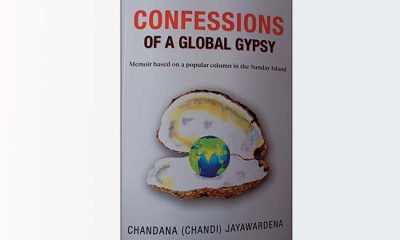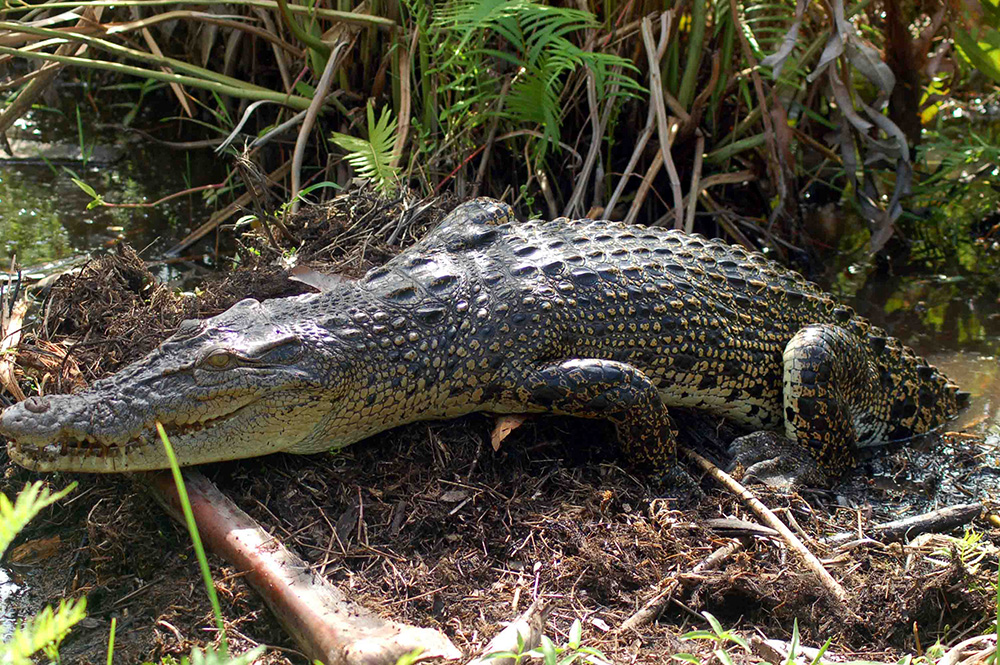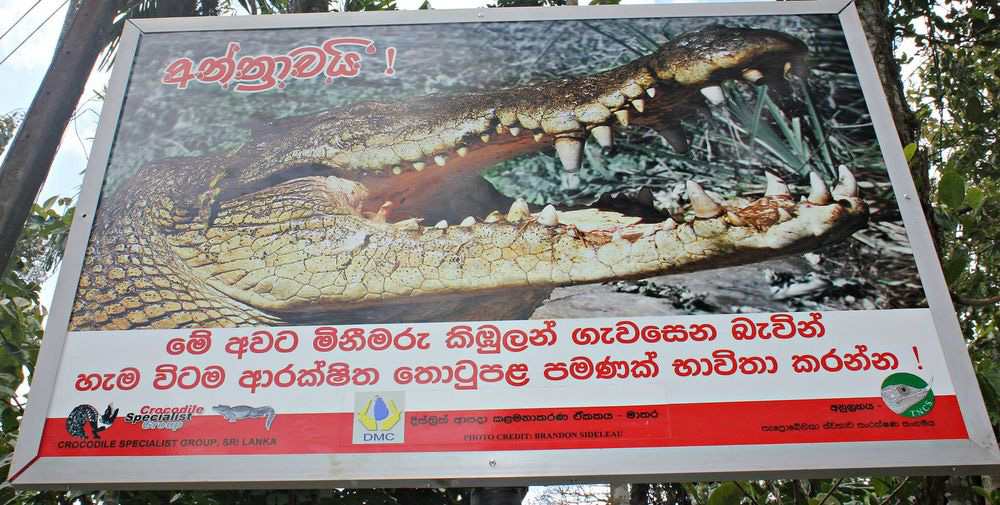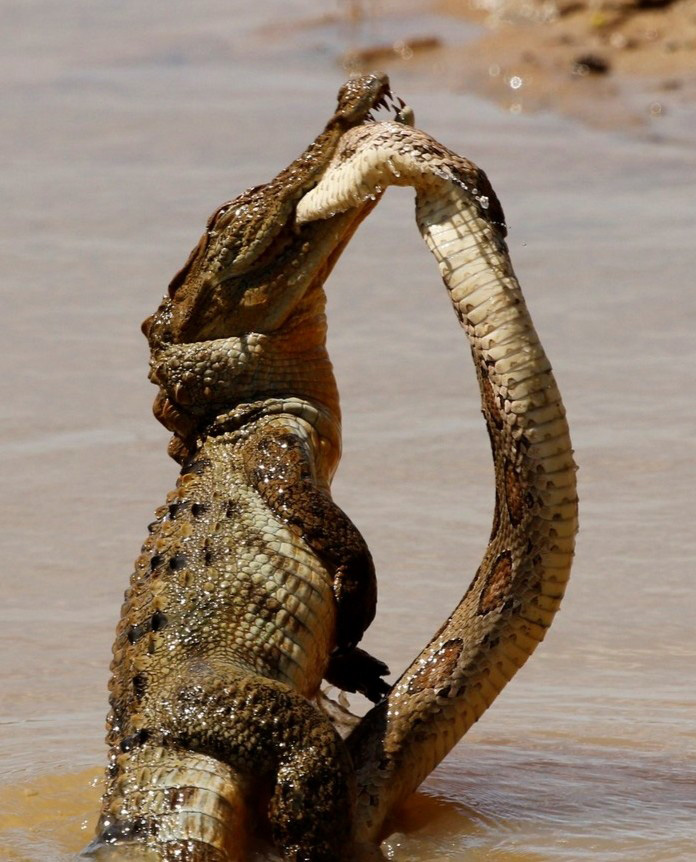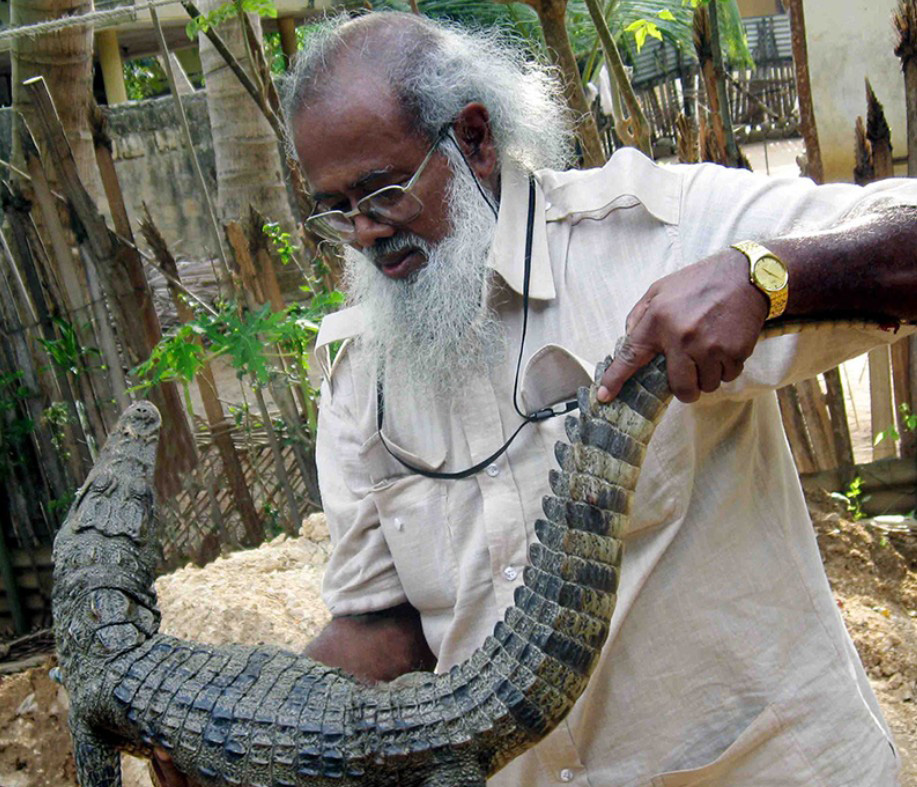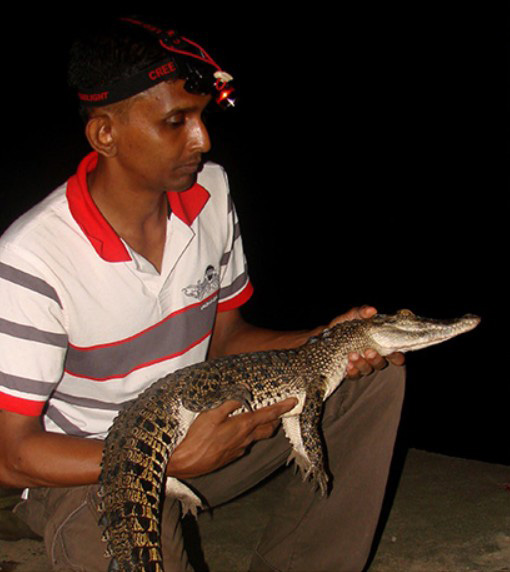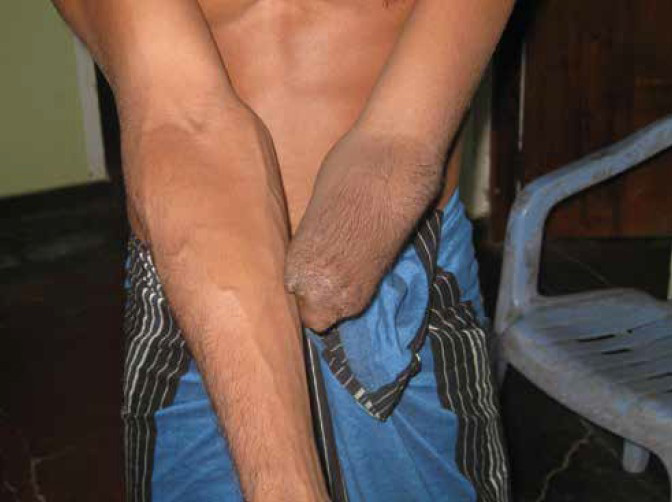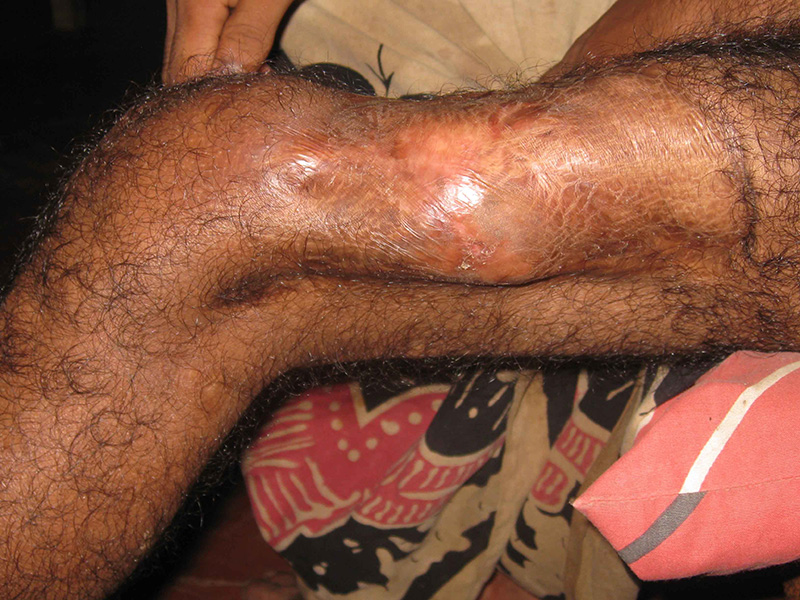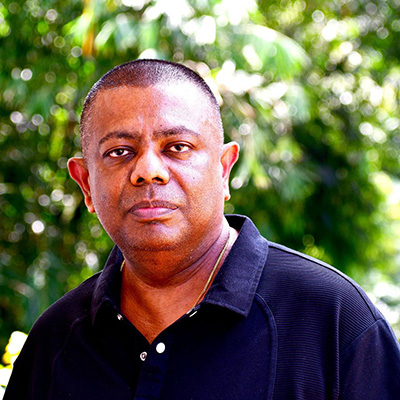Features
Simon (Sriyantha) Senaratne: Lawyer, CEO & Leisure Business Visionary
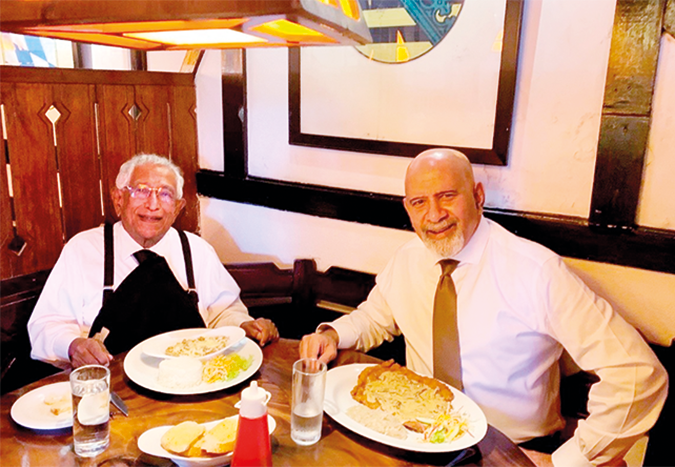
PLACES, PEOPLE & PASSIONS (3Ps)
Part five
Dr. Chandana (Chandi) Jayawardena DPhil
President – Chandi J. Associates Inc. Consulting, Canada
chandij@sympatico.ca
Profile
Simon is the founder and Precedent Partner of ‘Simon & Associates’, a well-established corporate law firm. He was the first Managing Director of ‘Walkers Tours’ the leisure arm of John Keells and led the development of their first hotel – Habarana Village. He was also one of the first Sri Lankan investors in the Maldives leisure industry. He is a social activist, an active Rotarian, and a past President of the Sri Lanka YMCA movement and the Ceylon Bible Society. His wife, Anthea, a short story writer, and Simon have two children and three grandchildren.
I have met Simon only four times over a period of 46 years: in 1977, 1980, 1983, and then after 40 years, in 2023. Each meeting was special, and I was inspired each time…
A Low-Key Leader
When I commenced working in resort hotels in the south coast of Sri Lanka in 1973, Walkers Tours & Travels Limited (later rebranded Walkers Tours) was the most influential and the leading tour operator in the island. They represented two of the largest European tour operators, from West Germany and Denmark, who were actively promoting tourism in Sri Lanka. Young hoteliers in the south coast loved dealing with fun-loving and friendly people who coordinated the Walkers Tours operations at hotels during that early stage of the organized tourism in Sri Lanka. They made us feel that we all were a big family involved in the building a young leisure industry in Sri Lanka.
Walkers Tours team who interacted with us regularly included Sri Lankan travel trade legends such as Norman Impett and Neville Arnolda, as well as their younger colleagues such as Christopher de Alwis, Bobby Jordan, and Jansi Ponniah. However, we only heard very little about their boss, who was a young lawyer, Sriyantha (Simon) Senaratne, who had been appointed as the Managing Director of Walkers Tours in 1971. Our friends respected their boss, who was the key business strategist in the corporate office but did not interfere with the operations experts of his company. That reflected the leadership style of a visionary leisure industry leader.
As a part of the business expansion vision of the Managing Director, Walkers Tours entered the hotel industry in 1973 with a unique project in a remote area – Habarana. After that Walkers Tours soon became the leader in hotel management in Sri Lanka. Just before the opening of the Village, Simon and his team finalized an agreement with Dr. Neville Fernando to manage his Hotel Swanee in Beruwala. After that, within the next two years, Walkers Tours took over the management of three other hotels. Those were Hotel Dulmini in Beruwala owned by a local businessman, Sanasuma Hotel in Weerawila owned by film idol Gamini Fonseka, and Hotel Ceysands in Bentota owned by Lalith Kotelawala. That was the foundation of the largest hotel company in Sri Lanka today.
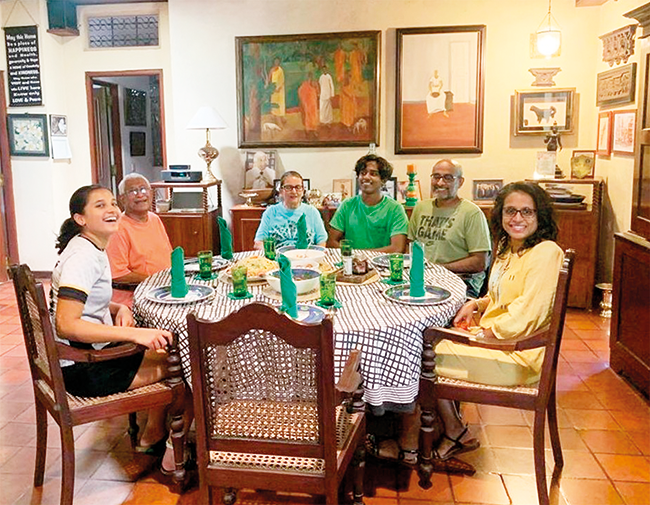
Simon having a relaxing meal at home with close family – (L to R) granddaughter Audrey, Simon, wife Anthea, grandson Akash, son-in-law Dinesh, and daughter Sonali
Our First Meeting in 1977
In the summer of 1977, Walkers Tours decided to organize a one-week-long coach tour around Sri Lanka for representatives from all hotels in Sri Lanka providing rooms to their clients. As the Assistant Manager and Executive Chef, I represented Coral Gardens Hotel in this tour. It turned out to be a fun-filled, thank you tour. It was a great, public relations initiative by Walkers Tours with their hotel industry partners.
The day after the trip when I returned to the Coral Gardens Hotel, Captain D. A Wickramasinghe (Captain Wicks), called me. He said that “I now work at the corporate office of John Keells/Walkers Tours Group, and I need to meet with you urgently to discuss something very important.” We met the next day. He explained that Walkers Tours had taken over the Hotel Ceysands management from the owners – Ceylinco Group, and Captain Wicks was appointed as the General Manager of Hotel Ceysands.
“I report to a fine gentleman, Mr. Sriyantha Senaratne, who has given me a free hand,” Captain Wicks said. I told him, “I have heard so many great things about Mr. Senaratne, but never had the pleasure of meeting him, yet.” After a few weeks, I joined the hotel re-opening team of Hotel Ceysands, as the Executive Chef and Food & Beverage Manager. I met Mr. Sriyantha Senaratne for the first time at Hotel Ceysands during our pre-opening period. I had a brief chat with this soft-spoken gentleman. I was impressed to hear that it was he who initiated the Habarana Village hotel project, despite a few barriers.
Job Offer in 1980
In 1980, Mr. Sriyantha Senaratne now as the Managing Director of rival company – Gemini Tours were completing the Sigiriya Village project. I was approached by the architect who designed both Habarana Village and Sigiriya Village – Somaratne de Silva, who made an offer to me to be the hotel opening Manager of the Sigiriya Village. “Simon and I are very impressed with you, and we would like you to join us” he said. It was an attractive offer, and I met Simon to thank him, but I did not accept the offer.
Chief Guest in 1983
In 1980 I married Captain Wicks’s daughter, and a year later commenced a family business with him – Streamline Services (Pvt.) Ltd., initially as a travel agency specializing in outbound travels, in Nepal, India and Thailand. As a Director of the company, I ran the Streamline Hotel Management Training Section. We had lectures on Saturdays and Sundays. With the increased business and student intake, we organized two award ceremonies a year.
Captain Wicks and I decided to invite two industry leaders whom we highly respected, as the chief guests of our award ceremonies – Mr. Herbert Cooray (Chairman of Jetwing Hotels Group, as well as the Tourist Hotels Association of Sri Lanka) and Mr. Sriyantha Senaratne (Managing Director of Gemini Management Services Ltd.). At the brink of the commencement of the civil war in Sri Lanka, he gave an inspiring keynote address to my students.
After meeting Mr. Senaratne at our 1983 awards ceremony, I lost touch with him for 40 years. Soon after the war started, I left for the United Kingdom to do my graduate studies, and Mr. Senaratne returned to his first love – law.
Re-connection after 40 years in 2023
After reading an episode of my newspaper column: ‘Confessions of a Global Gypsy’ dedicated to my time as the General manager of The Lodge and The Village, Habarana, I received more than the normal volume of reader’s mail. One was a long e-mail from a person with whom I had no contact for forty years – Mr. Sriyantha (Simon) Senaratne.
He wrote to me: “Chandana, this is a voice from the past. I have been following with great interest your series of articles on your life in the leisure industry appearing in the Sunday Island. Firstly, I want to thank you very much for the kind references that you have made about me personally in some of your articles. I would like to mention the background to Habarana Village, which almost did not happen.”
After exchanging a couple of further e-mails, he kindly agreed to collaborate with me in writing a question-and-answer article. During my last visit to Sri Lanka in March and April in 2023, we agreed to meet him after 40 years, in the well-appointed office of his law firm located in Galle Face Court II. After a nostalgic chat when we caught up our news of four decades over 40 minutes, he asked me: “Chandana, do you like German food?”
He then hosted me to lunch at the nearby Bavarian German Restaurant and Pub. Over lunch, I asked him the following 10 questions for this article. After that we communicated over a dozen e-mails clarifying and re-writing sections. As the old saying goes, “There ain’t no such thing as a free lunch!” especially when you are hosted by one of most successful corporate lawyers in the country!
Q: Out of all the places you have visited in Sri Lanka and overseas, what is your favorite and most interesting place?
A: Japan stands out in my memory as the most interesting, evocative and outstanding place I have visited. As one arrives you are immediately transported to an entirely different world and culture than you have ever experienced. The culture, manners and the discipline stands out in exceptional contrast to other places. Their rock gardens leaves you mesmerized. They are the most talented, cultured and most polite people I have ever met.
Q: Out of all the inspiring people you have met, who inspired you most?
A: I am an octogenarian and have been inspired by many people in my lifetime. At Trinity College I was exposed to the most committed and dedicated staff, who moulded my character. At the university it was Bishop Lakshman Wickremesinghe, a charismatic personality, brilliant intellect but yet a very simple, a down to earth human being. He taught me in life not to stand aside, but always to lend a hand to the less fortunate segments of our society.
In the law – At Julius & Creasy it was John Byrnell, the partner under whom I worked. He advised me “remember when you first meet a client he comes heavily burdened with his problems, when he leaves you, he must leave with the feeling that his burden is now on your shoulder.” He aptly summarized the very ethos of the profession, which has guided me all my life. In business – N. S. O. Mendis.
Q: At the present time, what is your key passion in life?
A: I have always believed that education is the only way to break through poverty. My wife and I make it a priority in our lives now, to fund the educational activities of the economically marginalized children in remote villages. We work in remotes villages in Anuradhapura, Vaharai and surrounding villages in the East Coast and in the deep South. I believe we have to give back what we have received.
Q: In leading a law firm with 500 corporate clients, what does your schedule look like on a normal work day?
A: During my early days of setting up the firm, I would work long hours virtually every single day, meeting clients, meeting counsel and travelling to sites which were of interest to my clients. Having established the firm on a good foundation, we have a brilliant, talented and efficient team of lawyers and chartered secretaries in whose hands I can confidently leave the nitty, gritty of running the firm. I still work every day, but with a lesser intensity. I balance my life, spending a lot of time with my family travelling together, working on our charity projects and reading widely and voraciously.
Q: In 1970 when you returned to Sri Lanka from the USA, you worked for one of the great corporate leaders in Ceylon of that period – Mr. N. S. O. Mendis. What are the key lessons you learnt from him?
A: Mr. N. S. O. Mendis had an extremely keen mind. He lived a simple life. In business he had a legendary ability to make investments. His visits to London were reviewed with apprehension by the sterling company directors, as they always wondered whether they would be the next acquisition. He had an excellent reputation with the London banks. In his operational style he left the day to day management entirely to the Directors whom he appointed and would have a fortnightly discussion with them.
The biggest lesson I learnt from him was when he told me “Sriyantha, in your business and professional life never ever lose your temper with the person sitting opposite you. Whatever outragous remark he would make, listen patiently and calmly and only then answer – a word spoken in anger can never be taken back.” I have never forgotten that lesson.
Q: At the age of 30, when you became the Managing Director at Walkers Tours, you were new to the leisure industry, but led a team of highly talented and experienced leisure industry professionals. How did you handle that?
A: When I became MD of Walkers Tours I had no experience whatsoever in the leisure industry. I was fortunate that there were experienced professional hands who were running Walkers Tours. In particular I would mention Neville Arnolda, and Norman Impett. I also recruited Christopher de Alwis who was an excellent PR person. I worked with the team and made them feel that they were partners and I believe that helped. I soon became quite experienced having met the CEO’s of the then two existing significant travel firms in Europe Hugo Stinnes, President of Neckemann Reisen and Pastor Krogager of Tjæreborg. They were very knowledgeable and I learnt much from them.
Q: By leading the Habarana Village project, as the first village style setting of a hotel in Sri Lanka, how did you make Walkers Tours, an innovative trend setter for others to follow?
A: I studied the operational pattern of the company and realized that the margins as a travel agent were extremely thin, but the highest margins were made by the hotel operators. When I analysed the tour patterns, I realized that most tourists visiting the cultural triangle divided their time between Sigiriya, Anuradhapura and Polonnaruwa. I saw an immediate opportunity for a hotel in a central location, as that would enable a three night stay in one hotel. Accordingly the idea for Habarana Village was born and of course it set a trend with the kind of village style cottages that were set up, instead of a conventional style hotel. For this concept credit belongs to the visionary architect Somaratne de Silva. This was a trend setter. I also believe that it set up another trend whereby travel companies also became owners of hotels where they were able to control the whole package.
Q: As one of the first Sri Lankan investors in the Maldives leisure industry, how did you inspire other organizations to follow your footsteps?
A: I visited the Maldives because I observed that some groups were travelling from Colombo to the Maldives and they spoke very highly of the Islands. At that time there were no direct flights from Europe to the Maldives. I visited the main island Male and an island called Vellasaru. I was struck by the pristine beaches and the turquoise blue water, the fish, of different shapes, colours and sizes, swimming around your feet as you got into the water and you could wade far into the sea as it was protected by a reef all around.
We had nothing comparable to that in Sri Lanka. I was struck by the contrast. I had a gut feeling that Maldives would in a few years be a magnet to tourists from all over the world, as each island captured privacy, as the other islands were spread far and wide in the Maldivian archipelago. I suppose the fact that I had invested in a hotel in the main island and in another separate island, made the industry here sit up and take notice.
Q: As a social activist, an active Rotarian, and a past President of the Sri Lanka YMCA movement and the Ceylon Bible Society, what were your main contributions to our society?
A: As President of the Rotary Club of Colombo North, the YMCA and the Bible Society, I became totally immersed in the activities of each different Society. My contribution to each of these societies was to ensure that their primary objects were properly funded, and encouraging and motivating a team to give of their best. The Rotary is a society which serves the community in welfare work.
It helps individuals, villages and projects in urban areas, helping to uplift the living standards of the people they reach out to. The YMCA too is a social movement that undertakes similar activities but is founded on the Christian principles. The Bible society is primarily involved in printing, publishing, distributing and translating the Bible to as many people as possible, thus spreading the word of God.
Q: You have worked very hard as a CEO for over 50 years. How do you balance your work and family life?
A: It has been a principle in my work life that I do not carry a file home. My home life has been devoted entirely to my wife and children and I ensured that I spent as much time as possible with them and in particular when I needed to travel during my involvement with the leisure industry, whenever there was a conference out of the country I would take my entire family. I think my children benefited greatly being exposed to different cultures. Also in my hotel visits I would as far as possible take my family. As a matter of routine in my children’s younger days I would drop them at school and re-arrange my schedule to personally pick them up from school.
as possible with them and in particular when I needed to travel during my involvement with the leisure industry, whenever there was a conference out of the country I would take my entire family. I think my children benefited greatly being exposed to different cultures. Also in my hotel visits I would as far as possible take my family. As a matter of routine in my children’s younger days I would drop them at school and re-arrange my schedule to personally pick them up from school.
Next week, 3Ps will feature the Sri Lankan Chef par excellence, and a National Treasure…
Features
When floods strike: How nations keep food on the table

Insights from global adaptation strategies
Sri Lanka has been heavily affected by floods, and extreme flooding is rapidly becoming one of the most disruptive climate hazards worldwide. The consequences extend far beyond damaged infrastructure and displaced communities. The food systems and supply networks are among the hardest hit. Floods disrupt food systems through multiple pathways. Croplands are submerged, livestock are lost, and soils become degraded due to erosion or sediment deposition. Infrastructural facilities like roads, bridges, retail shops, storage warehouses, and sales centres are damaged or rendered inaccessible. Without functioning food supply networks, even unaffected food-producing regions struggle to continue daily lives in such disasters. Poor households, particularly those dependent on farming or informal rural economies, face sharp food price increases and income loss, increasing vulnerability and food insecurity.
Many countries now recognie that traditional emergency responses alone are no longer enough. Instead, they are adopting a combination of short-term stabilisation measures and long-term strategies to strengthen food supply chains against recurrent floods. The most common immediate response is the provision of emergency food and cash assistance. Governments, the World Food Programme, and other humanitarian organisations often deliver food, ready-to-eat rations, livestock feed, and livelihood support to affected communities.
Alongside these immediate measures, some nations are implementing long-term strategic actions. These include technology- and data-driven approaches to improve flood preparedness. Early warning systems, using satellite data, hydrological models, and advanced weather forecasting, allow farmers and supply chain operators to prepare for potential disruptions. Digital platforms provide market intelligence, logistics updates, and risk notifications to producers, wholesalers, and transporters. This article highlights examples of such strategies from countries that experience frequent flooding.
China: Grain Reserves and Strategic Preparedness
China maintains a large strategic grain reserve system for rice, wheat, and maize; managed by NFSRA-National Food and Strategic Reserves Administration and Sinograin (China Grain Reserves Corporation (Sinograin Group), funded by the Chinese government, that underpins national food security and enables macro-control of markets during supply shocks. Moreover, improvements in supply chain digitization and hydrological monitoring, the country has strengthened its ability to maintain stable food availability during extreme weather events.
Bangladesh: Turning Vulnerability into Resilience
In recent years, Bangladesh has stood out as one of the world’s most flood-exposed countries, yet it has successfully turned vulnerability into adaptive resilience. Floating agriculture, flood-tolerant rice varieties, and community-run grain reserves now help stabilise food supplies when farmland is submerged. Investments in early-warning systems and river-basin management have further reduced crop losses and protected rural livelihoods.
Netherlands, Japan: High-Tech Models of Flood Resilience
The Netherlands offers a highly technical model. After catastrophic flooding in 1953, the country completely redesigned its water governance approach. Farmland is protected behind sea barriers, rivers are carefully controlled, and land-use zoning is adaptive. Vertical farming and climate-controlled greenhouses ensure year-round food production, even during extreme events. Japan provides another example of diversified flood resilience. Following repeated typhoon-induced floods, the country shifted toward protected agriculture, insurance-backed farming, and automated logistics systems. Cold storage networks and digital supply tracking ensure that food continues to reach consumers, even when roads are cut off. While these strategies require significant capital and investment, their gradual implementation provides substantial long-term benefits.
Pakistan, Thailand, Indonesia, and Vietnam: Reform in Response to Recurrent Floods
In contrast, Pakistan and Thailand illustrate both the consequences of climate vulnerability and the benefits of proactive reform. The 2022 floods in Pakistan submerged about one-third of the country, destroying crops and disrupting trade networks. In response, the country has placed greater emphasis on climate-resilient farming, water governance reforms, and satellite-based crop monitoring. Pakistan as well as India is promoting crop diversification and adjusting planting schedules to help farmers avoid the peak monsoon flood periods.
Thailand has invested in flood zoning and improved farm infrastructure that keep markets supplied even during severe flooding. Meanwhile, Indonesia and Vietnam are actively advancing flood-adapted land-use planning and climate-resilient agriculture. For instance, In Vietnam’s Mekong Delta, pilot projects integrate flood-risk mapping, adaptive cropping strategies, and ecosystem-based approaches to reduce vulnerability in agricultural and distribution areas. In Indonesia, government-supported initiatives and regional projects are strengthening flood-risk-informed spatial planning, adaptive farming practices, and community-based water management to improve resilience in flood-prone regions. (See Figure 1)
 The Global Lesson: Resilience Requires Early Investment
The Global Lesson: Resilience Requires Early Investment
The global evidence is clear: countries that invest early in climate-adaptive agriculture and resilient logistics are better able to feed their populations, even during extreme floods. Building a resilient future depends not only on how we grow food but also on how we protect, store, and transport it. Strengthening infrastructure is therefore central to stabilising food supply chains while maintaining food quality, even during prolonged disruptions. Resilient storage systems, regional grain reserves, efficient cold chains, improved farming infrastructure, and digital supply mapping help reduce panic buying, food waste, and price shocks after floods, while ensuring that production capacity remains secure.
Persistent Challenges
However, despite these advances, many flood-exposed countries still face significant challenges. Resources are often insufficient to upgrade infrastructure or support vulnerable rural populations. Institutional coordination across the agriculture, disaster management, transport, and environmental sectors remains weak. Moreover, the frequency and scale of climate-driven floods are exceeding the design limits of older disaster-planning frameworks. As a result, the gap between exposure and resilience continues to widen. These challenges are highly relevant to Sri Lanka as well and require deliberate, gradual efforts to phase them out.
The Role of International Trade and global markets
When domestic production falls in such situations, international trade serves as an important buffer. When domestic production is temporarily reduced, imports and regional trade flows can help stabilise food availability. Such examples are available from other countries. For instance, In October 2024, floods in Bangladesh reportedly destroyed about 1.1 million tonnes of rice. In response, the government moved to import large volumes of rice and allowed accelerated or private-sector imports of rice to stabilize supply and curb food price inflation. This demonstrates how, when domestic production fails, international trade/livestock/food imports (from trade partners) acted as a crucial buffer to ensure availability of staple food for the population. However, this approach relies on well-functioning global markets, strong diplomatic relationships, and adequate foreign exchange, making it less reliable for economically fragile nations. For example, importing frozen vegetables to Sri Lanka from other countries can help address supply shortages, but considerations such as affordability, proper storage and selling mechanisms, cooking guidance, and nutritional benefits are essential, especially when these foods are not widely familiar to local populations.
Marketing and Distribution Strategies during Floods
Ensuring that food reaches consumers during floods requires innovative marketing and distribution strategies that address both supply- and demand-side challenges. Short-term interventions often include direct cash or food transfers, mobile markets, and temporary distribution centres in areas where conventional marketplaces become inaccessible. Price stabilisation measures, such as temporary caps or subsidies on staple foods, help prevent sharp inflation and protect vulnerable households. Awareness campaigns also play a role by educating consumers on safe storage, cooking methods, and the nutritional value of unfamiliar imported items, helping sustain effective demand.
Some countries have integrated technology to support these efforts; in this regard, adaptive supply chain strategies are increasingly used. Digital platforms provide farmers, wholesalers, and retailers with real-time market information, logistics updates, and flood-risk alerts, enabling them to reroute deliveries or adjust production schedules. Diversified delivery routes, using alternative roads, river transport, drones, or mobile cold-storage units, have proven essential for maintaining the flow of perishable goods such as vegetables, dairy, and frozen products. A notable example is Japan, where automated logistics systems and advanced cold-storage networks help keep supermarkets stocked even during severe typhoon-induced flooding.
The Importance of Research, Coordination, and Long-Term Commitment
Global experience also shows that research and development, strong institutional coordination, and sustained national commitment are fundamental pillars of flood-resilient food systems. Countries that have successfully reduced the impacts of recurrent floods consistently invest in agricultural innovation, cross-sector collaboration, and long-term planning.
Awareness Leads to Preparedness
As the summary, global evidence shows that countries that act early, plan strategically, and invest in resilience can protect both people and food systems. As Sri Lanka considers long-term strategies for food security under climate change, learning from flood-affected nations can help guide policy, planning, and public understanding. Awareness is the first step which preparedness must follow. These international experiences offer valuable lessons on how to protect food systems through proactive planning and integrated actions.
(Premaratne (BSc, MPhil, LLB) isSenior Lecturer in Agricultural Economics Department of Agricultural Systems, Faculty of Agriculture, Rajarata University. Views are personal.)
Key References·
Cabinet Secretariat, Government of Japan, 2021. Fundamental Plan for National Resilience – Food, Agriculture, Forestry and Fisheries / Logistics & Food Supply Chains. Tokyo: Cabinet Secretariat.
· Delta Programme Commissioner, 2022. Delta Programme 2023 (English – Print Version). The Hague: Netherlands Delta Programme.
· Hasanuddin University, 2025. ‘Sustainable resilience in flood-prone rice farming: adaptive strategies and risk-sharing around Tempe Lake, Indonesia’, Sustainability. Available at: https://www.mdpi.com/2071-1050/17/6/2456 [Accessed 3 December 2025].
· Mekong Urban Flood Resilience and Drainage Programme (TUEWAS), 2019–2021. Integrated urban flood and drainage planning for Mekong cities. TUEWAS / MRC initiative.
· Ministry of Agriculture and Rural Affairs, People’s Republic of China, 2025. ‘China’s summer grain procurement surpasses 50 mln tonnes’, English Ministry website, 4 July.
· National Food and Strategic Reserves Administration (China) 2024, ‘China purchases over 400 mln tonnes of grain in 2023’, GOV.cn, 9 January. Available at: https://english.www.gov.cn/archive/statistics/202401/09/content_WS659d1020c6d0868f4e8e2e46.html
· Pakistan: 2022 Floods Response Plan, 2022. United Nations / Government of Pakistan, UN Digital Library.
· Shigemitsu, M. & Gray, E., 2021. ‘Building the resilience of Japan’s agricultural sector to typhoons and heavy rain’, OECD Food, Agriculture and Fisheries Papers, No. 159. Paris: OECD Publishing.
· UNDP & GCF, 2023. Enhancing Climate Resilience in Thailand through Effective Water Management and Sustainable Agriculture (E WMSA): Project Factsheet. UNDP, Bangkok.
· United Nations Development Programme (UNDP), 2025. ‘Rice Bank revives hope in flood hit hill tracts, Bangladesh’, UNDP, 19 June.
· World Bank, 2022. ‘Bangladesh: World Bank supports food security and higher incomes of farmers vulnerable to climate change’, World Bank press release, 15 March.
Features
Can we forecast weather precisely?

Weather forecasts are useful. People attentively listen to them but complain that they go wrong or are not taken seriously. Forecasts today are more probabilistically reliable than decades ago. The advancement of atmospheric science, satellite imaging, radar maps and instantly updated databases has improved the art of predicting weather.
Yet can we predict weather patterns precisely? A branch of mathematics known as chaos theory says that weather can never be foretold with certainty.
The classical mechanics of Issac Newton governing the motion of all forms of matter, solid, liquid or gaseous, is a deterministic theory. If the initial conditions are known, the behaviour of the system at later instants of time can be precisely predicted. Based on this theory, occurrences of solar eclipses a century later have been predicted to an accuracy of minutes and seconds.
The thinking that the mechanical behaviour of systems in nature could always be accurately predicted based on their state at a previous instant of time was shaken by the work of the genius French Mathematician Henri Poincare (1864- 1902).
Eclipses are predicted with pinpoint accuracy based on analysis of a two-body system (Earth- Moon) governed by Newton’s laws. Poincare found that the equivalent problem of three astronomical bodies cannot be solved exactly – sometimes even the slightest variation of an initial condition yields a drastically different solution.
A profound conclusion was that the behaviour of physical systems governed by deterministic laws does not always allow practically meaningful predictions because even a minute unaccountable change of parameters leads to completely different results.
Until recent times, physicists overlooked Poincare’s work and continued to believe that the determinism of the laws of classical physics would allow them to analyse complex problems and derive future happenings, provided necessary computations are facilitated. When computers became available, the meteorologists conducted simulations aiming for accurate weather forecasting. The American mathematician Edward Lorenz, who turned into a reputed meteorologist, carried out such studies in the early 1960s, arrived at an unexpected result. His equations describing atmospheric dynamics demonstrated a strange behaviour. He found that even a minute change (even one part in a million) in initial parameters leads to a completely different weather pattern in the atmosphere. Lorenz announced his finding saying, A flap of a butterfly wing in one corner of the world could cause a cyclone in a far distant location weeks later! Lorenz’s work opened the way for the development branch of mathematics referred to as chaos theory – an expansion of the idea first disclosed by Henri Poincare.
We understand the dynamics of a cyclone as a giant whirlpool in the atmosphere, how it evolves and the conditions favourable for their origination. They are created as unpredictable thermodynamically favourable relaxation of instabilities in the atmosphere. The fundamental limitations dictated by chaos theory forbid accurate forecasting of the time and point of its appearance and the intensity. Once a cyclone forms, it can be tracked and the path of movement can be grossly ascertained by frequent observations. However, absolutely certain predictions are impossible.
A peculiarity of weather is that the chaotic nature of atmospheric dynamics does not permit ‘long – term’ forecasting with a high degree of certainty. The ‘long-term’ in this context, depending on situation, could be hours, days or weeks. Nonetheless, weather forecasts are invaluable for preparedness and avoiding unlikely, unfortunate events that might befall. A massive reaction to every unlikely event envisaged is also not warranted. Such an attitude leads to social chaos. The society far more complex than weather is heavily susceptible to chaotic phenomena.
by Prof. Kirthi Tennakone (ktenna@yahoo.co.uk)
Features
When the Waters Rise: Floods, Fear and the ancient survivors of Sri Lanka
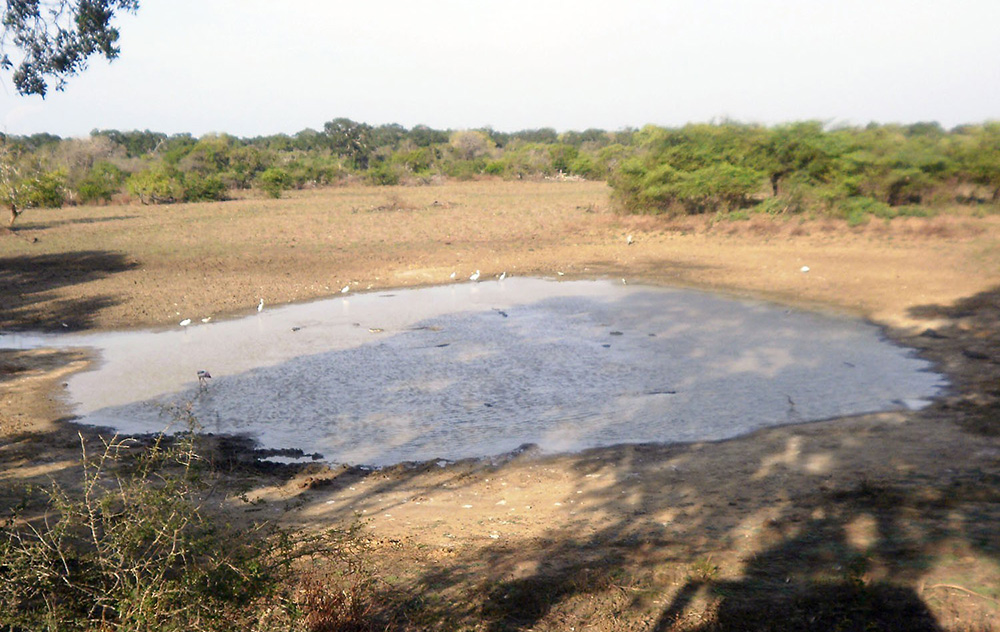
The water came quietly at first, a steady rise along the riverbanks, familiar to communities who have lived beside Sri Lanka’s great waterways for generations. But within hours, these same rivers had swollen into raging, unpredictable forces. The Kelani Ganga overflowed. The Nilwala broke its margins. The Bentara, Kalu, and Mahaweli formed churning, chocolate-brown channels cutting through thousands of homes.
When the floods finally began to recede, villagers emerged to assess the damage, only to be confronted by another challenge: crocodiles. From Panadura’s back lanes to the suburbs of Colombo, and from the lagoons around Kalutara to the paddy fields of the dry zone, reports poured in of crocodiles resting on bunds, climbing over fences, or drifting silently into garden wells.
For many, these encounters were terrifying. But to Sri Lanka’s top herpetologists, the message was clear: this is what happens when climate extremes collide with shrinking habitats.
“Crocodiles are not invading us … we are invading floodplains”
Sri Lanka’s foremost crocodile expert, Dr. Anslem de Silva, Regional Chairman for South Asia and Iran of the IUCN/SSC Crocodile Specialist Group, has been studying crocodiles for over half a century. His warning is blunt.
“When rivers turn into violent torrents, crocodiles simply seek safety,” he says. “They avoid fast-moving water the same way humans do. During floods, they climb onto land or move into calm backwaters. People must understand this behaviour is natural, not aggressive.”
In the past week alone, Saltwater crocodiles have been sighted entering the Wellawatte Canal, drifting into the Panadura estuary, and appearing unexpectedly along Bolgoda Lake.
“Saltwater crocodiles often get washed out to sea during big floods,” Dr. de Silva explains. “Once the current weakens, they re-enter through the nearest lagoon or canal system. With rapid urbanisation along these waterways, these interactions are now far more visible.”
- An adult Salt Water Crocodile (Crocodylus porosus) (Photo -Madura de Silva)
- Adult Mugger (Crocodylus plaustris) Photo -Laxhman Nadaraja
- A Warning sign board
- A Mugger holding a a large Russell ’s viper (Photo- R. M. Gunasinghe)
- Anslem de Silva
- Suranjan Karunarathna
This clash between wildlife instinct and human expansion forms the backdrop of a crisis now unfolding across the island.
A conflict centuries old—now reshaped by climate change
Sri Lanka’s relationship with crocodiles is older than most of its kingdoms. The Cūḷavaṃsa describes armies halted by “flesh-eating crocodiles.” Ancient medical texts explain crocodile bite treatments. Fishermen and farmers around the Nilwala, Walawe, Maduganga, Batticaloa Lagoon, and Kalu Ganga have long accepted kimbula as part of their environment.
But the modern conflict has intensified dramatically.
A comprehensive countrywide survey by Dr. de Silva recorded 150 human–crocodile attacks, with 50 fatal, between 2008 and 2010. Over 52 percent occurred when people were bathing, and 83 percent of victims were men engaged in routine activities—washing, fishing, or walking along shallow margins.
Researchers consistently emphasise: most attacks happen not because crocodiles are unpredictable, but because humans underestimate them.
Yet this year’s flooding has magnified risks in new ways.
“Floods change everything” — Dr. Nimal D. Rathnayake
Herpetologist Dr. Nimal Rathnayake says the recent deluge cannot be understood in isolation.
“Floodwaters temporarily expand the crocodile’s world,” he says. “Areas people consider safe—paddy boundaries, footpaths, canal edges, abandoned land—suddenly become waterways.”
Once the water retreats, displaced crocodiles may end up in surprising places.
“We’ve documented crocodiles stranded in garden wells, drainage channels, unused culverts and even construction pits. These are not animals trying to attack. They are animals trying to survive.”
According to him, the real crisis is not the crocodile—it is the loss of wetlands, the destruction of natural river buffers, and the pollution of river systems.
“When you fill a marsh, block a canal, or replace vegetation with concrete, you force wildlife into narrower corridors. During floods, these become conflict hotspots.”
Past research by the Crocodile Specialist Group shows that more than 300 crocodiles have been killed in retaliation or for meat over the past decade. Such killings spike after major floods, when fear and misunderstanding are highest.
“Not monsters—ecosystem engineers” — Suranjan Karunaratne
On social media, flood-displaced crocodiles often go viral as “rogue beasts.” But conservationist Suranjan Karunaratne, also of the IUCN/SSC Crocodile Specialist Group, says such narratives are misleading.
“Crocodiles are apex predators shaped by millions of years of evolution,” he says. “They are shy, intelligent animals. The problem is predictable human behaviour.”
In countless attack investigations, Karunaratne and colleagues found a repeated pattern: the Three Sames—the same place, the same time, the same activity.
“People use the same bathing spot every single day. Crocodiles watch, learn, and plan. They hunt with extraordinary patience. When an attack occurs, it’s rarely random. It is the culmination of observation.”
He stresses that crocodiles are indispensable to healthy wetlands. They: control destructive catfish populations, recycle nutrients, clean carcasses and diseased fish, maintain biodiversity, create drought refuges through burrows used by amphibians and reptiles.
“Removing crocodiles destroys an entire chain of ecological services. They are not expendable.”
Karunaratne notes that after the civil conflict, Mugger populations in the north rebounded—proof that crocodiles recover when given space, solitude, and habitat.
Floods expose a neglected truth: CEEs save lives—if maintained In high-risk communities, Crocodile Exclusion Enclosures (CEEs) are often the only physical barrier between people and crocodiles. Built along riverbanks or tanks, these enclosures allow families to bathe, wash, and collect water safely.
Yet Dr. de Silva recounts a tragic incident along the Nilwala River where a girl was killed inside a poorly maintained enclosure. A rusted iron panel had created a hole just large enough for a crocodile to enter.
“CEEs are a life-saving intervention,” he says. “But they must be maintained. A neglected enclosure is worse than none at all.”
Despite their proven effectiveness, many CEEs remain abandoned, broken or unused.
Climate change is reshaping crocodile behaviour—and ours
Sri Lanka’s floods are no longer “cycles” as described in folklore. They are increasingly intense, unpredictable and climate-driven. The warming atmosphere delivers heavier rainfall in short bursts. Deforested hillsides and filled wetlands cannot absorb it.
Rivers swell rapidly and empty violently.
Crocodiles respond as they have always done: by moving to calmer water, by climbing onto land, by using drainage channels, by shifting between lagoons and canals, by following the shape of the water.
But human expansion has filled, blocked, or polluted these escape routes.
What once were crocodile flood refuges—marshes, mangroves, oxbow wetlands and abandoned river channels—are now housing schemes, fisheries, roads, and dumpsites.
Garbage, sand mining and invasive species worsen the crisis
The research contained in the uploaded reports paints a grim but accurate picture. Crocodiles are increasingly seen around garbage dumps, where invasive plants and waste accumulate. Polluted water attracts fish, which in turn draw crocodiles.
Excessive sand mining in river mouths and salinity intrusion expose crocodile nesting habitats. In some areas, agricultural chemicals contaminate wetlands beyond their natural capacity to recover.
In Borupana Ela, a short study found 29 Saltwater crocodiles killed in fishing gear within just 37 days.
Such numbers suggest a structural crisis—not a series of accidents.
Unplanned translocations: a dangerous human mistake
For years, local authorities attempted to reduce conflict by capturing crocodiles and releasing them elsewhere. Experts say this was misguided.
“Most Saltwater crocodiles have homing instincts,” explains Karunaratne. “Australian studies show many return to their original site—even if released dozens of kilometres away.”
Over the past decade, at least 26 Saltwater crocodiles have been released into inland freshwater bodies—home to the Mugger crocodile. This disrupts natural distribution, increases competition, and creates new conflict zones.
Living with crocodiles: a national strategy long overdue
All three experts—Dr. de Silva, Dr. Rathnayake and Karunaratne—agree that Sri Lanka urgently needs a coordinated, national-level mitigation plan.
* Protect natural buffers
Replant mangroves, restore riverine forests, enforce river margin laws.
* Maintain CEEs
They must be inspected, repaired and used regularly.
* Public education
Villagers should learn crocodile behaviour just as they learn about monsoons and tides.
* End harmful translocations
Let crocodiles remain in their natural ranges.
* Improve waste management
Dumps attract crocodiles and invasive species.
* Incentivise community monitoring
Trained local volunteers can track sightings and alert authorities early.
* Integrate crocodile safety into disaster management
Flood briefings should include alerts on reptile movement.
“The floods will come again. Our response must change.”
As the island cleans up and rebuilds, the deeper lesson lies beneath the brown floodwaters. Crocodiles are not new to Sri Lanka—but the conditions we are creating are.
Rivers once buffered by mangroves now rush through concrete channels. Tanks once supporting Mugger populations are choked with invasive plants. Wetlands once absorbing floodwaters are now levelled for construction.
Crocodiles move because the water moves. And the water moves differently today.
Dr. Rathnayake puts it simply:”We cannot treat every flooded crocodile as a threat to be eliminated. These animals are displaced, stressed, and trying to survive.”
Dr. de Silva adds:”Saving humans and saving crocodiles are not competing goals. Both depend on understanding behaviour—ours and theirs.”
And in a closing reflection, Suranjan Karunaratne says:”Crocodiles have survived 250 million years, outliving dinosaurs. Whether they survive the next 50 years in Sri Lanka depends entirely on us.”
For now, as the waters recede and the scars of the floods remain, Sri Lanka faces a choice: coexist with the ancient guardians of its waterways, or push them into extinction through fear, misunderstanding and neglect.
By Ifham Nizam
-

 News6 days ago
News6 days agoWeather disasters: Sri Lanka flooded by policy blunders, weak enforcement and environmental crime – Climate Expert
-
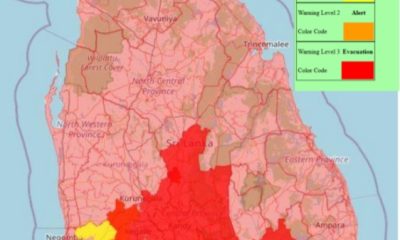
 Latest News7 days ago
Latest News7 days agoLevel I landslide RED warnings issued to the districts of Badulla, Colombo, Gampaha, Kalutara, Kandy, Kegalle, Kurnegala, Natale, Monaragala, Nuwara Eliya and Ratnapura
-
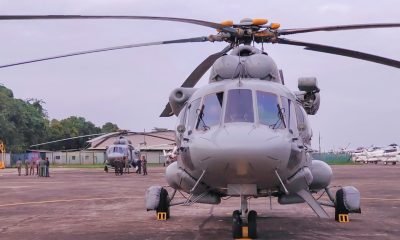
 Latest News7 days ago
Latest News7 days agoINS VIKRANT deploys helicopters for disaster relief operations
-
News3 days ago
Lunuwila tragedy not caused by those videoing Bell 212: SLAF
-

 Latest News4 days ago
Latest News4 days agoLevel III landslide early warnings issued to the districts of Badulla, Kandy, Kegalle, Kurunegala, Matale and Nuwara-Eliya
-

 News2 days ago
News2 days agoLevel III landslide early warning continue to be in force in the districts of Kandy, Kegalle, Kurunegala and Matale
-

 Features4 days ago
Features4 days agoDitwah: An unusual cyclone
-

 Latest News5 days ago
Latest News5 days agoUpdated Payment Instructions for Disaster Relief Contributions

